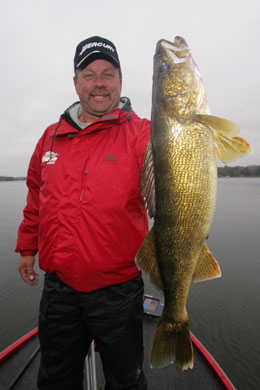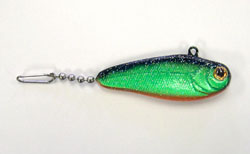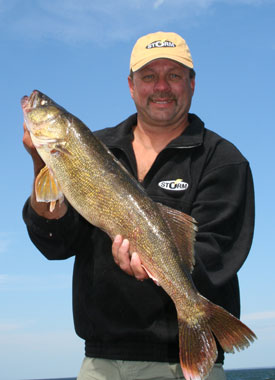
Get in line, wait in line, draw a line, follow the line. Walk the line, toe the line, don’t cross the line, get Aunt Bea on the line.
Lines give us a measure of order. Take them away, and chaos rules whether it’s a trip to the gas station or a task as simple as launching a boat.
On the water, we troll breaklines and contour lines, we strive to maintain vertical jigging lines, we tune crankbaits to run straight lines, and we sometimes cast anchor lines.
Savvy anglers have also discovered the advantages of in-line trolling weights when used in conjunction with spinner rigs for late spring and early summer walleyes.
Today’s in-lines have evolved from egg sinkers and keel weights to baitfish-style sinkers that add a realistic look to a rig and snap weight systems that add the versatility to deal with nearly any condition.
May walleyes are hungry after the rigors of the April spawn. The best place for them to find an easy meal is in shallow water often associated with emerging weedbeds, fertile bays or rocky shorelines. As long as they don’t feel threatened, they will remain in those areas, so stained water and wave action provide optimum situations. Seek out locations where the wind is stirring up the shallows and, in cases where there is no wind, fish areas where the wind was blowing into most recently.
Because these fish are only beginning to congregate and the water is still on the chilly side, they may be scattered over large areas and still not active enough to chase crankbaits. That makes trolling spinner rigs an effective presentation because you can cover water at a slow pace and get a walleye’s attention from a considerable distance with the vibration and flash of the spinner blades, the color patterns created by your blades and beads, and the scent of live crawlers.
I always have a couple of dozen spinner rigs tied up and spooled for use on these early season outings. My basic rig consists of a six-foot snell of 12- or 14-pound monofilament with two No. 4 bait hooks (I also keep some three-hook rigs handy for use when fish seem to be biting short) and a row of beads designed to match the baitfish species present in a particular body of water, whether that’s emerald shiners, perch, alewife, shad, juvenile white bass, etc. At the end of the line, tie a quality barrel swivel.
Start with blades smaller than the 6s, 7s or 8s you might choose later in the season when the walleyes are more active. I’ve had much better success early in the year using 3s, 4s and 5s. Quick-change clevises are a must because they allow me to experiment with blade sizes and colors with a minimum of down time.
Once you’ve selected a rig, you’ll need to figure out how best to present it. To get our rigs into the strike zone and keep them there requires a weighting game plan that can deal with depths ranging from three feet to 30 feet.
Extremely shallow water may not require any weight or, at most, a split shot or in-line bullet-style weight. Wind and wave action are sometimes enough to move the boat along at the desired 8.0-1.0 mph without any additional motor power, and the swells can add a surging and sinking motion to your rigs that often triggers strikes. In this situation, I use my MinnKota Engine Mount trolling motor only to make directional corrections.
It’s from the clearer depths of six feet to 30 where realistic baitfish in-lines like Uncle Josh’s new Baitfish Trolling Weights enhance a spread and actually simplify the entire process of fishing spinners, besides providing precise depth control.
These weights feature holographic finishes that can be matched to the color patterns of the spinner rig and they also work well as an attractor. The rounded noses that help them bounce off rock and wood where other weights might become wedged or tangled and a bead chain on the back end that helps eliminate line twist and makes it quick and simple to change rigs. Attach a snap swivel to the end of your main line and it’s also a snap to change weight sizes as you move deeper.
 Another advantage of in-line, baitfish-style weights is the nature of shallow-water walleyes. They can be explosive and acrobatic, often coming immediately to the surface, and you’ll keep a larger percentage of them hooked if you don’t have to deal with weights that are swinging around on a three-way, sliding violently up and down the line or must be removed in the middle of the battle.
Another advantage of in-line, baitfish-style weights is the nature of shallow-water walleyes. They can be explosive and acrobatic, often coming immediately to the surface, and you’ll keep a larger percentage of them hooked if you don’t have to deal with weights that are swinging around on a three-way, sliding violently up and down the line or must be removed in the middle of the battle.
Electronics will help you locate fish. Humminbird’s Side-Imaging technology identifies walleyes that move off to the sides as a boat passes overhead and will show you what’s underneath the boat in deeper water. Weight your rigs so they track about a foot or so above the fish you see on sonar because walleyes, with the location of their eyes, tend to move up to feed but not down.
 When the water is rough, Off-Shore snap weights are often a better option than in-line weights. Because they can be attached 20 to 40 feet ahead of a rig, they absorb some of the violent movement that occurs with crashing waves and bouncing boats, thus giving the walleyes a better look and a better opportunity to grab your crawler.
When the water is rough, Off-Shore snap weights are often a better option than in-line weights. Because they can be attached 20 to 40 feet ahead of a rig, they absorb some of the violent movement that occurs with crashing waves and bouncing boats, thus giving the walleyes a better look and a better opportunity to grab your crawler.
No matter what depth you are fishing, spreading your lines is critical. A set of Off-Shore planer boards will carry your lures out away from the boat and allow you to cover more water as you pursue these scattered fish. When conditions are right, I use my boards in conjunction with a dead stick. Extremely stained water is one situation where dead-sticking can be effective, drift-fishing with no motor propulsion is another and targeting deeper walleyes that won’t spook as a boat passes over. I will also use the baitfish trolling weights in place of a bottom bouncer.
I choose this approach only as a matter of keeping things simple and efficient. It allows me to experiment with different rigs, blades and weights without bringing in one board and resetting others, and it helps me get one line cleared when I’ve got a fish on another.
There are times when it pays big dividends to move all your lines to the same side of the boat. We’ve all experienced days when one side of the boat seems to catch all the fish, even when we’re running the same rigs on both sides. It’s no coincidence. There’s something about the way the boards are riding and the rigs are tracking that makes one side more productive. Why not move as many lines to that side as you can?
May is one of the best months to fish for walleyes. They’re relatively predictable, hungry and usually not hard to find.
Sometimes, it’s as simple as getting in line.










